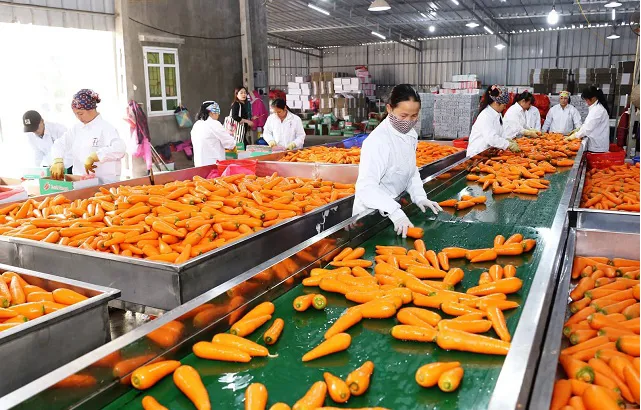Vietnam fruit, vegetable exports rise above 6% to over US$900 million in Q1
Not only witnessing a sharp increase in trade turnover, there has been a greater diversification in export market.
Despite severe Covid-19 impacts in the first quarter of this year, Vietnam’s exports of fruit and vegetable still posted a positive growth of 6.1% year-on-year to US$944 million.
| Processing carrots at Tan Huong Agricultural Products and Foodstuffs Processing at Cam Giang district. Photo: Duy Anh |
“The result is thanks to Vietnam’s effective containment of the Covid-19 pandemic that helps avoid any disruption to export activities,” stated the Import-Export Department under the Ministry of Industry and Trade.
Not only is it witnessing a sharp increase in trade turnover, but there has been a greater diversification in export market. While China remained Vietnam’s largest buyer of agricultural products by spending US$350 million in Vietnam’s farm exports in the January – February period, accounting for 62.5% of total, other markets have seen a strong growth in import value, including Taiwan (China) with an increase of 43.1%, Australia (30.6%), and Malaysia (32.5%).
“The presence of free trade agreements, including the EVFTA, CPTPP, and RCEP, is opening the door for local enterprises to boost export of fruit and vegetables in international market,” said Deputy Director of Import-Export Department Tran Thanh Hai.
“The UKVFTA, scheduled to take effect from May 1, could be another growth driving force for Vietnam’s farm produce,” added Hai.
Under the trade deal, 94% of total 547 categories of vegetables and fruit from Vietnam to the UK would be subject to 0% import tariff, putting Vietnamese main tropical products including lychees, longan, dragon fruit and pineapple in an advantageous condition to compete with those from countries that has not had a FTA with the UK, including Brazil, Thailand and Malaysia.
Improving product quality an urgent priority
Addressing current shortcoming of Vietnam’s agricultural sector, General Secretary of the Vietnam Fruit and Vegetable Association Dang Phuc Nguyen said origin tracing continues to be a major weakness, as the production process remains highly fragmented.
Meanwhile, production under the Global Good Agricultural Practices (GlobalGAP) and Vietnamese Good Agricultural Practices (VietGAP) only accounts for 10-15% of total cultivating areas, making it difficult for local traders to meet exporting requirements of large quantity.
“The priority for Vietnam’s agricultural sector is to improve product quality and ensure food safety standards under VietGAP, Global GAP,” stated Nguyen.












